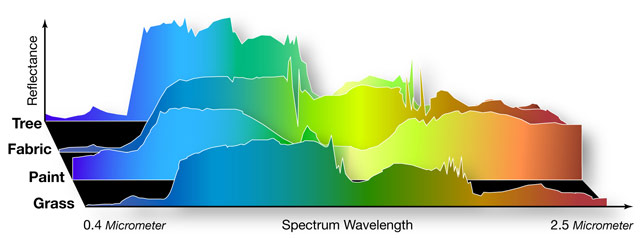New Sensors - Machtres Fighters
Main menu
- index
- Air Services
-
Planes
- list
- Weapons
- Gallery
- transport
- liners
- X projects
- Air Forces
- Air Disasters
- red-bull
- Specials
- Choppers
- History
- Aircraft Carriers
-
Information
- Argentine
- Space
New Sensors
 Bees see what we don't. Their eyes are adept at seeing in ultraviolet, so much so that flowers have evolved colorful patterns visible only in UV to attract bees' attention.
Bees see what we don't. Their eyes are adept at seeing in ultraviolet, so much so that flowers have evolved colorful patterns visible only in UV to attract bees' attention.
The vision of these buzzing insects is just one example of what lies beyond the limits of our naked eyes. In the bands beyond what we can see, there's lots of data that can be used to identify objects. But a new breed of man-
Instead of UV, hyperspectral sensors use reflections from hundreds of bands in the infrared range of the electromagnetic spectrum. While cameras (and eyeballs) identify targets by their shape or by contrasts of light and dark, hyperspectral scanners can collect reflections at various IR wavelengths and automatically determine the material that a target is made of.
"You're collecting light energy," says Lesley Foster, director of mid-
The technology, developed for use in space, is now being fit onto unmanned aircraft. Last week at the Paris Air Show, the U.S. Air Force announced a program to field the first airborne tactical hyperspectral sensor. Raytheon engineers will outfit a Predator UAV with a sensor that can deliver hyperspectral imagery to users on the ground in real time.
How does it work?
When light reflects off materials, it produces a specific chemical signature unique to that material. If the signature is in a database of known materials, then a single pixel can provide enough information to identify a substance. The precision often depends on the depth of the library of signatures; for example, military paint on an armored vehicle can be differentiated from commercial paint used on civilian vehicles.
If you want to know why the military would be so interested in this, consider camouflage. If a green net covering an armored vehicle is hiding in a green jungle, human eyes can't pick it up. But a hyperspectral sensor sees material makeup, not color. It could spot the net because of the difference in reflection between man-
Foster says that near-

What does it mean?
Raytheon paved the way for hyperspectral sensors with its successful deployment of Artemis-
Now, with the Air Force starting a program to put these sensors on unmanned aircraft, the future could include UAVs that routinely find the invisible and hidden. Bringing this tech from space to the air means adapting the system with larger optics to collect enough photons and correcting for atmospheric disturbances, Foster says. But the payoff could come in changing the way UAVs are used. The Environmental Protection Agency could use them to spot spikes in smokestack emissions, farmers could monitor crop health, local police could scan for clandestine marijuana fields and border patrols could hunt for smuggling tunnels across the border. In the future, being hidden from view won't be enough to remain hidden from flying robots.